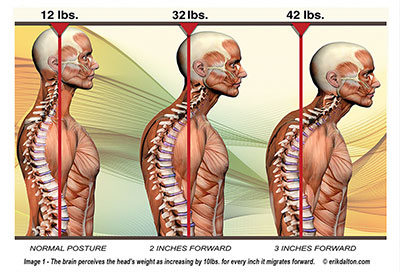
In today’s digital age, many of us find ourselves hunched over screens for hours on end—whether we’re working on a computer, browsing on our phones, or watching TV. This constant forward head posture has led to a growing problem known as “tech neck.” Tech neck refers to the strain and pain caused by poor posture related to prolonged screen time. As more people spend extended hours working at desks or using mobile devices, the prevalence of tech neck has skyrocketed.
Fortunately, there is hope. Chiropractic care offers effective interventions to combat tech neck and help restore proper posture. In this guide, we will explore chiropractic interventions for addressing tech neck and improving overall posture. Additionally, we’ll discuss the Tampa office workers’ posture correction guide and how office workers in the area can benefit from chiropractic solutions to alleviate tech neck discomfort.
What Is Tech Neck?
Tech neck is a term used to describe the discomfort and pain in the neck, shoulders, and upper back caused by poor posture when using digital devices. It typically occurs when a person tilts their head forward to look down at a screen, which creates excess strain on the muscles, ligaments, and joints in the neck and spine. Over time, this repetitive poor posture can lead to musculoskeletal issues such as stiffness, headaches, and even chronic pain.
Common symptoms of tech neck include:
- Neck pain or stiffness
- Shoulder discomfort
- Upper back pain
- Headaches
- Reduced mobility in the neck
- Fatigue
With the rise of remote work and digital device usage, many people are experiencing tech neck and other related posture issues. Fortunately, chiropractic care can offer effective solutions to alleviate these symptoms and promote better posture.
How Chiropractic Care Helps With Tech Neck
Chiropractors are trained to assess and treat musculoskeletal conditions, including those caused by tech neck. Through various therapeutic interventions, chiropractors can address misalignments in the spine, release tension in the muscles, and improve overall posture. Here’s how chiropractic care can help:
1. Spinal Adjustments to Correct Misalignments
Prolonged poor posture can lead to misalignments in the cervical spine (the neck area), which exacerbates neck pain and discomfort. Chiropractic adjustments are designed to realign the spine and restore its natural curvature. By correcting misalignments in the cervical spine, chiropractors can help relieve pressure on the nerves, reduce inflammation, and promote better nerve function.
Spinal adjustments are a highly effective way to address the root cause of tech neck. By restoring proper alignment, chiropractic care helps alleviate the pain and stiffness associated with tech neck while also improving overall spinal health.
2. Soft Tissue Therapy for Muscle Tension
Another key aspect of chiropractic care is the use of soft tissue therapy to address muscle tightness and tension. Tech neck can cause muscles in the neck, shoulders, and upper back to become tight and fatigued. Chiropractors often use techniques such as myofascial release and deep tissue massage to release muscle knots and reduce tension in these areas.
These therapies are effective in relieving the muscle discomfort caused by tech neck, improving blood flow to the affected areas, and promoting faster recovery. Soft tissue therapy is often combined with spinal adjustments for a comprehensive approach to treating tech neck.
3. Posture Education and Correction
A key element of chiropractic care for tech neck is educating patients on the importance of proper posture. Chiropractors provide posture correction exercises and tips to help individuals improve their alignment throughout the day. This may include advice on how to sit properly at a desk, maintain a neutral head position when using digital devices, and avoid slouching.
Chiropractors may also teach ergonomic practices to ensure that workstations are set up in a way that promotes optimal posture and reduces strain. For example, keeping the screen at eye level, using a chair that supports the lower back, and taking regular breaks from screen time are all important strategies for managing tech neck.
4. Strengthening and Stretching Exercises
To prevent tech neck from recurring, chiropractors often recommend specific strengthening and stretching exercises. These exercises target the muscles of the neck, upper back, and shoulders to improve strength and flexibility. Regular practice of these exercises can help keep the muscles balanced and prevent muscle strain.
Strengthening exercises may include:
- Neck extensions
- Shoulder shrugs
- Upper back rows
- Chest stretches
By incorporating these exercises into daily routines, patients can improve their posture, reduce muscle tension, and prevent the recurrence of tech neck.
Tampa Office Workers’ Posture Correction Guide
Office workers in Tampa are particularly susceptible to tech neck due to long hours spent in front of computers. The good news is that with the right approach, office workers can significantly improve their posture and reduce the risk of tech neck. Here’s a helpful Tampa office workers’ posture correction guide to implement throughout the workday:
1. Set Up an Ergonomic Workspace
A properly set-up workstation is key to avoiding tech neck. Ensure that your desk, chair, and computer monitor are positioned to promote good posture:
- Monitor Height: The top of your screen should be at or just below eye level. This prevents you from looking down and straining your neck.
- Chair Position: Your chair should support the lower back (lumbar spine) and allow your feet to rest flat on the floor.
- Keyboard and Mouse: Keep your keyboard and mouse at a height that allows your arms to be at a 90-degree angle when typing.
2. Take Frequent Breaks
Staying in one position for long periods can contribute to poor posture and neck pain. Be sure to take regular breaks throughout the day. Set a timer to remind you to stand up, stretch, and walk around every 30 to 60 minutes. This helps relieve tension and prevents the muscles from becoming stiff.
3. Practice Good Posture
During the workday, make a conscious effort to practice good posture. Keep your shoulders relaxed and avoid slouching. Try to maintain a neutral position for your head and neck, keeping them aligned with your spine. Avoid jutting your head forward when looking at the screen.
4. Perform Posture Exercises
Incorporating simple posture exercises into your routine can help prevent and alleviate tech neck. These exercises help strengthen the muscles that support your neck and back. Examples include chin tucks, neck rolls, and upper back stretches. Chiropractors often recommend these exercises to help improve posture and reduce muscle tension.
5. Stay Active Outside of Work
Physical activity is an essential part of preventing tech neck and improving overall posture. Incorporating regular exercise, such as yoga, swimming, or strength training, into your routine can help keep your muscles strong and flexible, reducing the likelihood of neck pain.
Conclusion
Tech neck is a common issue that affects many people, especially those who spend long hours working in front of computers or using digital devices. Fortunately, chiropractic care offers a range of effective interventions to address this problem. From spinal adjustments to soft tissue therapy and posture education, chiropractors can help you alleviate the discomfort associated with tech neck and improve your overall posture.
For Tampa office workers, following a posture correction guide and integrating chiropractic care into your wellness routine can make a significant difference in preventing and managing tech neck. By adopting ergonomic practices, taking regular breaks, and incorporating strength and stretching exercises, you can avoid the long-term effects of poor posture and improve your quality of life.
If you’re struggling with tech neck or other posture-related issues, consult with a chiropractor in Tampa to learn more about effective treatments and preventative care options. With the right approach, you can say goodbye to neck pain and hello to better posture and overall wellness
Write and Win: Participate in Creative writing Contest & International Essay Contest and win fabulous prizes.


